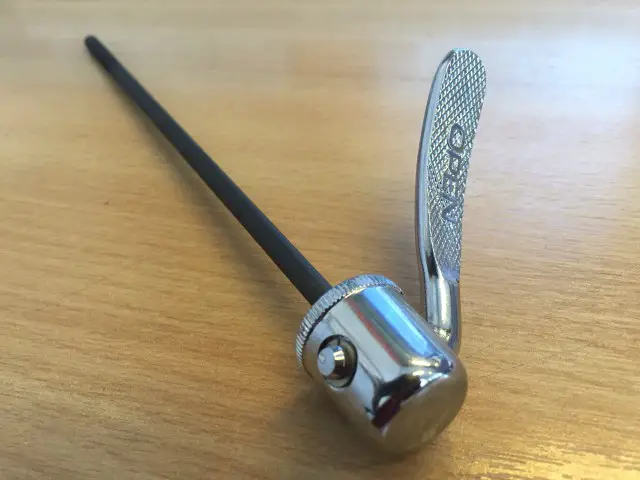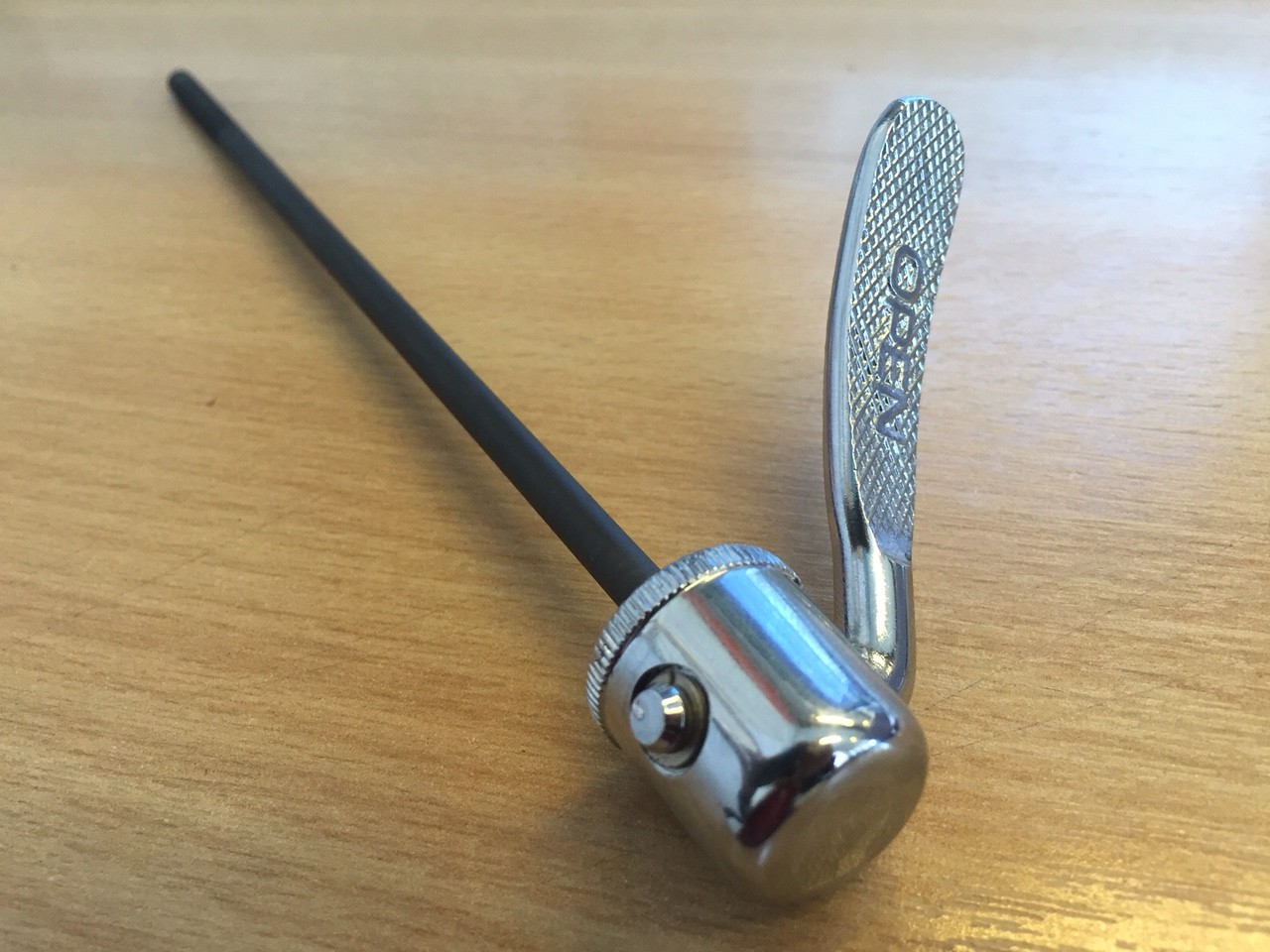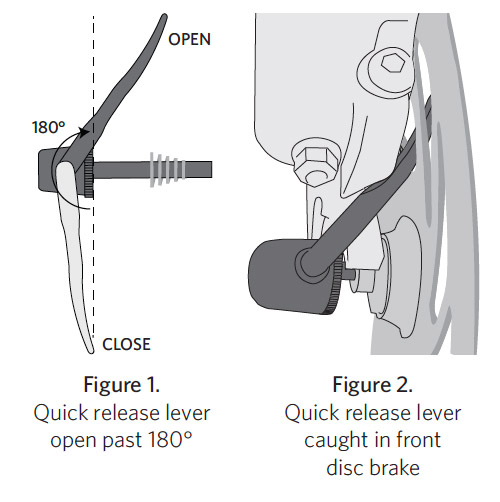Following on from the story last night first broken on our sister site Grit.cx here we’ve had a chat with TREK UK who have filled us in on more of the details behind this problem.
Firstly, the issue is with the type of Quick Release Skewer and NOT with any particular bike design. Indeed it is actually a particular design of QR that lies at the centre of this issue. The type of Skewer that opens beyond the 180 degree point is known as a QR11 type. This skewer is NOT made by Trek. It is in fact one of the most common types of skewer on the market and has been rebadged over the years by many bike brands including Shimano. It has been in production since 2000 and incredibly Trek have estimated that the number of TREK bikes that could potentially be affected in the EU alone is 692,000.
It’s also important to say that the QR11 type skewer is not defective in any way in of itself. It is simply the combination of this skewer with disc brakes that presents a danger. One simple solution, as we demonstrate in our video, is to simply clamp up your QR from the opposite side of your wheel, away from the disc and calliper.
https://vimeo.com/125677973
We demonstrated the problem with a mountain bike and you can see that to a certain extent the design of the suspension form limits the danger as the QR lever can’t swing round and make contact with the calliper and in most cases the worst that will happen is that you will get a wobbly wheel and hear the ching of the lever bouncing off the disc. However, the risk is much MUCH greater with rigid forks where the QR lever poses a risk (as shown in the illustration) of spinning round and actually jamming between the calliper and the disc. If that happens the outcome will undoubtedly be catastrophic.

The message is pretty clear though.
- This is not a problem restricted to TREK as many brands have used this QR11 over the years*
- Check any of your bikes that still use QR levers with discs and if you have one.
- Go buy a new QR that won’t kill you.
- Check you have done up your QR every ride because it’s a sensible thing to do anyway.
*Don’t be surprised if other companies start issuing recall notices very soon.
UPDATE! As pointed out by Brant below you should not rely on just swapping the QR round as that introduces a new risk of the QR undoing itself due to vibrations from riding. See this report here , written by long standing forumite and bike shop owner Ben Cooper of Kinetics, Glasgow.
UPDATE 2! According to the BIKEBIZ article here Trek have indicated that there have been three documented accidents with one ending in paralysis due to this particular model of QR making contact with a brake calliper.
Comments (38)
Leave Reply
Post Comment



Your advice is at odds with findings which suggests to avoid the QR skewer loosening, it should be on the disc side.
http://www.kinetics-online.co.uk/uncategorized/disc-brake-safety-issues/
Indeed. A temporary fix before you do point 3 and go get a new QR. And then there’s point 4 of course 🙂
People never read more than three points down.
I hope this doesn’t lead to lots of people swapping sides with skewers and us having a host of ejection issues 🙁
Its not like anyone can recommend going to buy a set of bolt through forks, as that will just lumber someone with rapidly outdating 100mm spaced forks instead of the new cool 110mm Boost variant which aren’t in the shops yet.
(post may contain irony)
Story updated to advise against swapping round QR. Bin it and get one that works like the first one we try in the video.
I’ve managed 15 years of QR and Disc brakes without killing myself so far. Personally I really don’t see the risk as being high enough to bother with. Much more likely to run over walking to the shops to buy milk….
Milk! Milk causes crashes!!! *pours milk in sink*
Is there not more risk of the wheel falling out, I know there is a ridge to prevent this on the forks but after a hard landing I would be more concerned about loosing my wheel.
Yes, but i’d guess your skewer coming undone is safer if said skewer doesn’t catch the disc and throw you over the bars. At least if it’s the correct skewer you’d get the chance to notice something amiss and sort it out (especially now that most forks have the dropouts angled to prevent the wheel ejection issue)
Advice for decades has been to have the QR handle on the opposite side from the disc rotor (to save burnt hands). Has there been a spate of associated wheel ejections?
So, if you fail to install your QR properly, your wheel may come undone, jam up, and throw you over the bars.
NO S*IT!
Isn’t this a potential problem on rear wheels too?
An amnesty on crappy QRs (old style internal and rubbish external) would be a good idea anyway and sell the modern excellent Deore ones for a fiver a set or something when you hand in your old ones unless any OEMs want to do a free recall on the above type and waive the cost.
The “wheel ejection” issue was due to the angle of the dropouts in relation to the disc brake mount.
The “QR loosening” issue is related to which side of the fork the QR lever is positioned.
non-disc side – some loosening
disc side – no loosening.
It’s in the Kinetics article above.
The two issues are separate, tho obviously a wheel can only come out the frame once the QR has come loose.
Are there any special considerations for forks with the brake mount on the drive side e.g. Cotic’s?
I guess the vibration issue is still valid, but the forces under braking will be in a different direction/plane?
for crying out loud, is this just a case of “ooo lets get people to suck eggs”, sounds very much as if somebodies had an accident through their own incompetence & has decided to blame the bike manufacturer because of their own stupidity.
Wasp on a baby’s face.
Seems to have happened before anyway… http://singletrackworld.com/forum/topic/my-friend-had-a-problem-with-his-skewer
Am I wrong… Or is this only a problem when the QR is completely undone and flapping about? I reckon the sound, basic advice would be to only ride with your QR done up.
It does make sense to have foolproof designs of course and companies need to look at their whole range of customers.
It was Russel Pinder who had the terrible accident – a friend of GoFAR/Singletrack in the very early days when the project to create a bike website first started. Just thought I’d mention it. He was a regular rider on the early trailquest scene.
Anyone with a 9mm QR is so not “enduro” as to not matter anyway!
#basicallyexpendable
😉
Seems like the bike industry are stealthily trying to force everyone into new forks and wheels to me……
By offering over 1 million qr upgrades and £15 voucher? Really? I mean Really? As a conspiracy, how the hell does that work exactly?
In this case a company is offering to upgrade a component not just for free but also with a discount voucher off a future gear purchase. That is all 1) entirely optional and 2) completely free. Where is the downside?
Sometimes, a recall is just a recall.
Wait…. You are just joking aren’t you 🙂
Admittedly, I haven’t been through all the links in your article but all you seem to say, is that people should buy a new qr or risk certain death.
Point 3 I think it is……
Which is a good idea. But you said it was a conspiracy to get us to buy new forks and wheels. The issue is with a skewer, not forks or wheels.
much a do about nothing really. the QR could be on the opposite side to the disc, no be done up properly, come loose, rider goes over a bump and the wheel comes off….
It’s a safety recall – let’s not be cynics….and I work in the Car Trade.
I like turtles.
I was completely unaware that you shouldn’t fit a QR to the non disc side due to loosening, I have always fitted mine that way as it seemed obvious in case of a puncture during a long descent when the disc would be hot, no accidental burns when undoing QR, not had one loosen yet, maybe just been lucky I suppose then.
Unaware too. The kinetics article put it forward as a possible based on a small sample size (1). Anyone know if it has been researched further?
(Goes off to check which side qr is on bikes…..)
Shimano’s instructions have always recommended having the lever on the opposite side to the rotor. Or, to quote their tech doc:
“• If the quick release lever is on the same side as the rotor, there is the danger that it may
interfere with the rotor, so check that it does not interfere.”
Always read the instructions people 🙂
Hi all,
We are recommending against simply swapping the QR to the driveside. That doesn’t eliminate the risk of it at some point be changed back to the non-driveside.
We want to get as many of these QRs off the market as possible. Unfortunately, we can only control how we do that on our bikes, but if you have ANY disc brake QR bike we would urge you to check it for QRs with the QR11 design.
To be clear: this issue is not due to a malfunction of the QR, but rather a design flaw that, with improper use, can potentially lead to injury.
We’re happy to answer any questions.
Really interesting. Having fettled bikes with those levers quite a lot in the past, the back they close so ‘far in’ always gave me the heebie-jeebies. And despite the advice about which side they should go on I think my advice was on the drive side at the front for that reason (possible interference with disk).
AFAIK no one died.
It’s a bit of a battle of the losers though, QR and disks isn’t a great combination, but I take my own advice and only use Shimano Flat profile MTB series QRs (the ally ones).
And a Maxle 😉
Hi trekbikes – rather than a ‘design flaw’ (AFAIK these QRs were designed long before bikes had discs) – isn’t it more like ‘User Error’? ie. not doing up skewers properly…
Hi Dez,
You are right about the history of the design predating disc brakes. It also predates through axles and other alternatives, which is why we don’t want to suggest a Pound range of bikes this impacts. We were using this QR design on some quite high end bikes back in the day.
To your other point, it is fair to say that the design flaw of QR11s does present itself in the presence of improper installation. This is why we want to be clear that if the QR is done up properly, that the issue ISN’T that it can potentially fly open, but rather that the issue arises when people haven’t installed the QR in the correct way, according to instructions.
However, it’s easy for those of us with years of experience to minimise the seriousness of this recall, simply because we know how to properly use a QR. But, as Mark so rightly pointed out even those of us who would never imagine ourselves making a ‘rookie mistake’ like not doing up a QR are exposed. For example, what if someone puts your wheel on for you? Or what if you are simply distracted by car park banter and aren’t devoting your usual level of attention?
More than that, though, what if you sell your bike later on to someone not as well-versed in how to use a QR on a disc wheel?
We consider the safety of you, the experienced riders, to be just as important as the (likely) larger number of people who have never been taught the correct way to use a QR, and think the ‘handle’ is a wingnut. We want to reduce the risk for everyone.
Not if they work loose – which does, occasionally, very rarely, happen.
This is just one of several scenarios where this component could lead to an otherwise avoidable accident.
I personally have no bikes that this is an issue with as all of my bikes use through axles. However, I can think of several of my friends who would be affected by this – not because they are the sorts of people to forget how to use a QR properly but because their kids have bikes that have this QR on them. Most kids bikes also come with disc brakes now too. So do we also apply the argument that if you can’t do up a QR properly you shouldn’t be riding a bike to our kids?
Or do the manufacturers do the responsible thing and make us all aware that there is a risk factor that they can simply mitigate by changing a cheap component for a better one BEFORE three documented cases turns into four?
Of course there’s the added benefit that this recall and the publicity around it has got thousands of people checking their QRs. That’s a good thing yeah?
Or to abbreviate all of the above…. “Won’t somebody think of the children!*’ 🙂
*and other idiots
An abbreviation of the above: “it’s still user error”!!
It’s been the aim of engineers and designers the centuries over to eliminate user error wherever possible. Today that process took another step forward.
My wife has a Trek with the QR11 lever and discs – but it’s about a 3 hour round trip back to the Trek dealer it came from, so I doubt it’ll make it there. Is there an alternative offered by Trek for people quite happy to change there own QR lever but who aren’t near one of their dealers?